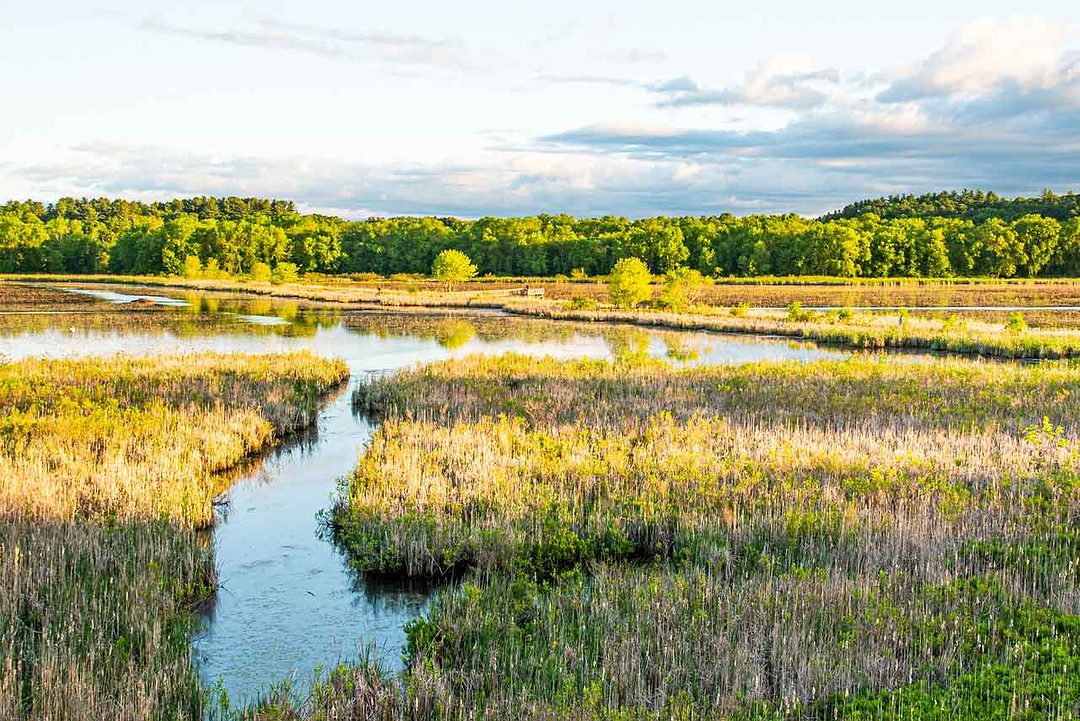Summer has always been a wonderful time to explore the many trails, parks, historic sites, and other natural wonders of Concord. During these stressful times, it’s more important than ever to take time to enjoy nature - to get outside and feel the sun and the breezes, to marvel at the plants and animals with which we share this world, and to find our best selves again. I’ve spent many years walking these trails and photographing the plants and animals found there. Over the years I’ve found a number of places that have become favorites. Here are a few I recommend to locals and visitors alike:
Great Meadows is a favorite place for those who enjoy quiet walks with lots of birds, critters, and special plants. It is an easy walk from town via the rail bed off Monument Street. There are several nice viewing spots including the tower at the parking lot off Munson Road, the deck on the causeway, and benches scattered around the trails. Great Meadows encompasses (looking west to east) Borden Pond, the upper impoundment, and the lower impoundment. The causeway runs between the upper and lower impoundments, and leads down to the Concord River. A trail to the left (north) of the causeway goes around the lower impoundment and back to the rail bed and parking lot. The best times to visit are early and late in the day – these are the best times to see the wildlife and to take pictures.

Buttrick Mansion
North Bridge, Buttrick Mansion, the Robbins House, and the grounds of the Old Manse combine to make a delightful place to stroll, check up on history, or have a picnic. The formal gardens of the Buttrick Mansion have beautiful views of the Concord River to the north and the North Bridge to the east. Look for the remains of the home of Captain David Brown and his wife Abigail. The remaining cellar hole shows the footprint of where they lived with 10 children and Uncle Elias. Your job is to figure out how they managed to all live in a place not much bigger than the wood shed. It is a pleasant walk from town to get to this cluster of interesting places, although it may take several visits to see everything.

Sudbury River
The Wild & Scenic Rivers ACT enacted by Congress in 1968 sought to preserve certain rivers with outstanding natural, cultural, and recreational values in a free-flowing condition for the enjoyment of present and future generations. Concord is blessed to have three Wild & Scenic Rivers; the Sudbury, the Assabet, and the Concord rivers. The Sudbury and the Assabet rivers convene at Egg Rock and form the Concord River, which flows north into the Merrimack River in Lowell and eventually flows out to sea at Newburyport and Plum Island. Both the Sudbury and the Assabet start and bow out from Westborough, Ma. To paddle or trail walk on these rivers is a different visual experience because they each have their own style. The Sudbury is slow moving and wider, the Assabet is faster moving, narrow and winding, while the Concord River is a mixture of the other two. Access points can be found using maps on the Organization for the Assabet, Sudbury, and Concord Rivers site at http://oars3rivers.org/

Battle Road
The Battle Road is a very nice place to stroll, jog, or bike on a hard-packed dirt road that the British followed during their retreat from the Battle of the North Bridge. The road meanders about five miles through beautiful farm fields and wooded areas. A footbridge crosses a marsh and passes many cellar holes of past farms, an old tavern, and homes. It is an easy walk now - but it was a tough trip for the British soldiers who marched the road while being shot at from behind stone walls by the Minutemen. The route can be accessed from the parking lot near Meriam’s Corner on Lexington Road where the Willow Pond Kitchen used to be (the lobster and beer was very good if one did not mind hanging animal heads staring at you from the walls). One could also drive to the Minute Man National Historical Park headquarters on route 2A in Lexington in order to break the distance up and then travel the eastern end of the Battle Road.

Walden Upper Trail
Walden Pond is not just a lovely pond. It is a glacially formed kettle hole with many glacial features such as eskers and vernal pools. Walden is the deepest lake in Massachusetts with clear, blue-green water (a lake is determined by depth and whether light reaches the bottom). Despite its extensive number of visitors and swimmers, it has an interesting way of staying clear…so far. There are many books about Walden that tell us of the history, geology, and hydrology and many are worth reading such as those of Robert Thorson. The pond was once owned by families such as Emerson, Wyman, and Hayward and then controlled by Middlesex County, and currently by the State Park and Recreation Department.
Henry Thoreau made Walden famous during his stay of two years, two months and two days (and wrote about his experience there). The majority of people wandering around the pond follow the Pond Trail along the pond edge. There is a special route on the north side that few use that I call the upper trail. It can be accessed by crossing Walden Street from the parking lot toward the paved ramp to the beach, but then following the path along the road toward Rt 2 for about 50 yards and taking a left turn and left again up an incline. This esker route drops down to Wyman’s meadow and across the wooden foot bridge. There is also an upper route on the western side from just beyond Thoreau’s cabin site that returns to the pond edge at Ice Fort Cove (this is where the ice was taken out to the railroad). The Thoreau Society shop at the visitor center has books about the pond that one would find interesting regarding this very special lake.
These are just a few of Concord’s stunning natural gems. I would encourage you to explore these treasures and more. Time in nature is time well spent, and balancing for the mind and the body. Enjoy!
Photography by Dave Witherbee


